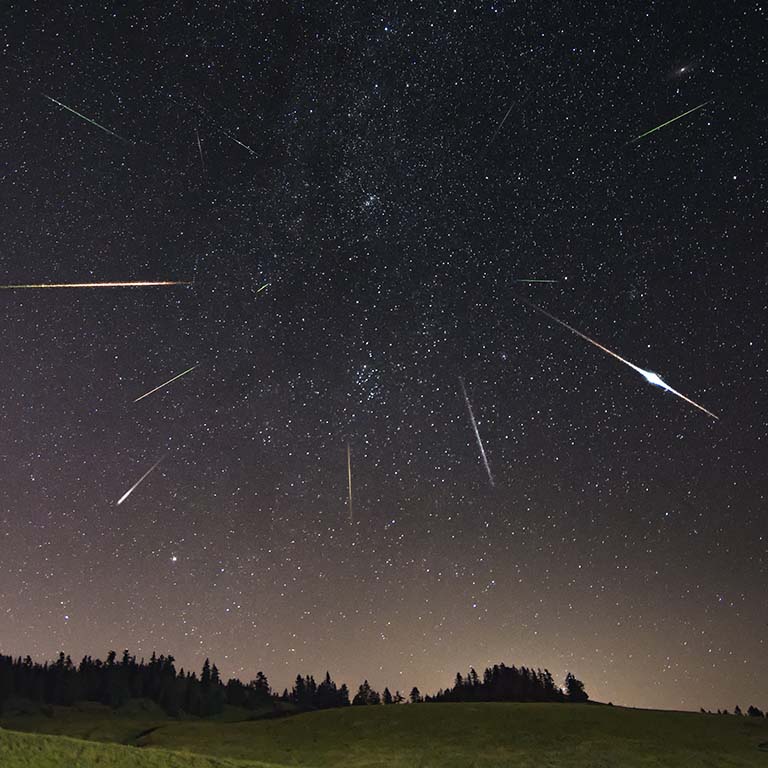For immediate release: August 1, 2021
BLOOMINGTON, Ind. -- The annual Perseid meteor shower is one of the most popular every year because it happens on warm summer nights, when gazing at the starry sky is always enjoyable. This year the Perseid shower will peak on the night of Aug. 12-13. The moon will set around 10:30 p.m. local time, providing ideal conditions for observing meteors. In a clear dark sky as many as 60 meteors per hour may be visible.
The Perseids will perform for most of August, though there will be fewer meteors to see the farther from the peak date you watch. If the peak is hidden by clouds, look for the bright streaks again as soon as the night sky is clear. To minimize the effect of local light pollution, try to avoid artificial lights.
Face east and look about halfway up the sky from the horizon. You won't need binoculars or a telescope, because the meteors move much too fast for those instruments. The Perseids produce more of the extremely bright meteors called fireballs than any other shower. The chances of seeing a fireball will be greatest near dawn.
The Perseids may appear anywhere in the sky, but they will seem to originate from a point called the radiant in the constellation Perseus, which gives these "shooting stars" their name. The higher the radiant is above the northeastern horizon, the more meteors will be visible. Perseus is just north of the W-shaped constellation Cassiopeia in the Milky Way. Meteors near the radiant will have short trails because we see them nearly straight on, while those far from the radiant will look longer because they are seen from the side.
Most meteor showers happen when Earth crosses the orbit of a comet, and the Perseids come from Comet Swift-Tuttle. The meteors are caused by particles released from the comet's nucleus and left behind in space. As Earth plows through this stream of debris, ranging in size from sand grains to pebbles, each particle slams into our atmosphere at a speed of more than 30 miles per second and burns up almost instantly from friction with air molecules. The resulting heat momentarily creates a streak of glowing air that we see as a meteor. All of this happens about 60 miles above the ground, regardless of how close some meteors may appear.
Planets
The outer planets Saturn and Jupiter will both be opposite the sun in our sky during August, presenting fine opportunities for viewing with any backyard telescope. Saturn will reach opposition on Aug. 2, rising in the southeast as the sun sets and reaching its highest elevation in the south around local midnight. The bright yellow planet will be easy to spot among the faint stars of the constellation Capricornus, and its famous rings will be tilted 18 degrees to our line of sight. Saturn's brightest moon, Titan, will be north of the planet on Aug. 3 and 19 and south of the planet on Aug. 11 and 26.
Jupiter will reach opposition on Aug. 19, rising an hour after Saturn in the constellation Aquarius. Any telescope will show details in the planet's atmosphere during the hour after midnight. Its four Galilean moons will also be easy to track.
Venus will dominate the western evening sky during August, glowing brilliantly 8 degrees high 45 minutes after sunset. By month's end Venus and the bright star Spica will be less than 7 degrees apart low in the west.
Mars will be 11 degrees west (lower right) of Venus and also 2 degrees from the white star Regulus on Aug. 1. Both Mars and Regulus will be 5 degrees high in the west a half hour after sunset. You'll need binoculars and a clear horizon to see them. They will set about an hour after the sun. The Red Planet will become harder to spot as it nears conjunction with the sun.
Mercury will be very low in the evening sky in August, setting 30 minutes after the sun. With luck you may catch Mercury and Mars in an extremely close conjunction on Aug. 18. Twenty minutes after sunset, brighter Mercury will be 4 degrees high and dim Mars will be less than 1 degree to the east.
Light pollution
If you look at the constellation Cassiopeia in the northeast on a clear summer night and can't see the Milky Way sprawling high across the sky from the northern to the southern horizon, it means your sky has significant light pollution. This is the case for about two-thirds of the world's population. The dimming of the night sky is caused by excessive artificial lighting, much of which is wasted. See the International Dark-Sky Association website for more information.
Moon phases
The moon will be new on Aug. 8, at first quarter on Aug. 15, full on Aug. 22, and at last quarter on Aug. 30.
Author: Hal Kibbey Email: hkibbey [at] gmail.com


 The College of Arts
The College of Arts